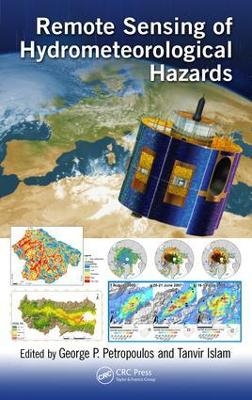
Remote Sensing of Hydrometeorological Hazards
Crc Press Inc (Verlag)
978-1-4987-7758-2 (ISBN)
Extreme weather and climate change aggravate the frequency and magnitude of disasters. Facing atypical and more severe events, existing early warning and response systems become inadequate both in scale and scope. Earth Observation (EO) provides today information at global, regional and even basin scales related to agrometeorological hazards. This book focuses on drought, flood, frost, landslides, and storms/cyclones and covers different applications of EO data used from prediction to mapping damages as well as recovery for each category. It explains the added value of EO technology in comparison with conventional techniques applied today through many case studies.
Dr. George P. Petropoulos is an Associate Professor in Remote Sensing & GIS in the Department of Geography & Earth Sciences (DGES) at Aberystwyth University in Wales, UK. He completed his graduate studies (MSc, PhD) at the University of London. Dr. Petropoulos’ research focuses on exploiting EO data alone or synergistically with land surface process models for computing key state variables of the Earth's energy and water budget, including energy fluxes and soil surface moisture. He is also conducting research on the application of remote sensing technology to land cover mapping and its changes occurred from either anthropogenic activities or geohazards (mainly floods, wildfires, frost). Dr. Petropoulos serves as a Council member and Trustee of the Remote Sensing & Photogrammetric Society (RSPSoC), he is Associate Editor and Editorial Board Member on several international peer-reviewed scientific journals in EO and environmental modelling. He has also convened the organisation of several scientific specialised sessions at international conferences. He is Editor/co-editor of 3 other books and co-author +55 peer-reviewed journal articles. He has developed fruitful collaborations with key scientists in his area of specialisation globally, and his research work so far has received international recognition via several noteworthy awards he has obtained. Tanvir Islam is with the NASA Jet Propulsion Laboratory and specializes in remote sensing observations. Presently, he is engaged with the development of advanced microwave calibration and retrieval algorithms for NASA’s Earth observing missions. Prior to joining NASA/JPL in 2015, he was with the NOAA/ NESDIS/STAR and worked on the development of satellite remote sensing algorithms, with an emphasis on microwave variational inversion techniques (2013–2015). He also held visiting scientist positions at the University of Tokyo, Japan as part of the NASA/ JAXA precipitation measurement missions (PMM) algorithm development team, in 2012 and at the University of Calgary, Alberta, Canada in 2015. He earned his PhD in remote sensing at the University of Bristol, Bristol, United Kingdom in 2012.
Section I: Remote Sensing of Drought 1. Drought and Remote Sensing: An Overview 2. Agricultural Drought Monitoring Using Satellite Soil Moisture and Other Remote Sensing Data over the Iberian Peninsula 3. Drought Assessments by Coupling Moderate Resolution Imaging Spectroradiometer Images and Weather Data: A Case Study in the Minas Gerais State, Brazil 4. The Added Value of Satellite Soil Moisture for Agricultural Index Insurance 5. Detecting the 2012 Drought in the Southeastern United States with Moderate Resolution Imaging Spectroradiometer- and Gravity Recovery and Climate Experiment-Based Drought Indicators Section II: Remote Sensing of Frost and Sea Ice Hazards 6. Frost and Remote Sensing: An Overview of Capabilities 7. Remote Sensing of Sea Ice Hazards: An Overview 8. Satellite Microwave Remote Sensing of Landscape Freeze–Thaw Status Related to Frost Hazard Monitoring 9. Temperature Fluctuation and Frost Risk Analysis on a Road Network by Coupling Remote Sensing Data, Thermal Mapping, and Geographic Information System Techniques Section III: Remote Sensing of Wildfires 10. Wildfires and Remote Sensing: An Overview 11. A Review on European Remote Sensing Activities in Wildland Fires Prevention 12. Remote Sensing of Fire Effects: A Review for Recent Advances in Burned Area and Burn Severity Mapping 13. Exploring the Relationships between Topographical Elements and Forest Fire Occurrences in Alberta, Canada 14. Quantifying the Interannual Variability of Wildfire Events across Portugal for the 2014–2015 Wildfires Using the Data from the European Forest Fire Information System Section IV: Remote Sensing of Flood 15. Satellite Remote Sensing of Floods for Disaster Response Assistance 16. Usefulness of Remotely Sensed Data for Extreme Flood Event Modeling: A Study Case from an Amazonian Floodplain 17. Large-Scale Flood Monitoring in Monsoon Asia for Global Disaster Risk Reduction Using MODIS/EOS Data 18. Introducing Flood Susceptibility Index Using Remote-Sensing Data and Geographic Information Systems: Empirical Analysis in Sperchios River Basin, Greece 19. Satellite-Based Precipitation for Modeling Floods: Current Status and Limitations Section V: Remote Sensing of Storms 20. Application of Remote-Sensing Images for Post-Wind Storm Damage Analysis 21. Analyzing Tropical Cyclones over India Using Precipitation Radar 22. Radar Rainfall Estimates for Debris-Flow Early Warning Systems: Effect of Different Correction Procedures on the Identification of Intensity–Duration Thresholds Section VI: Remote Sensing of Landslides 23. A Review of Unmanned Aerial Vehicles, Citizen Science, and Interferometry Remote Sensing in Landslide Hazards: Applications in Transportation Routes and Mining Environments 24. Landslide Susceptibility Assessment Mapping: A Case Study in Central Greece
| Erscheinungsdatum | 22.11.2017 |
|---|---|
| Zusatzinfo | 100 Illustrations, color; 115 Illustrations, black and white |
| Verlagsort | Bosa Roca |
| Sprache | englisch |
| Maße | 178 x 254 mm |
| Gewicht | 1315 g |
| Themenwelt | Informatik ► Grafik / Design ► Digitale Bildverarbeitung |
| Naturwissenschaften ► Geowissenschaften ► Geografie / Kartografie | |
| Naturwissenschaften ► Geowissenschaften ► Geologie | |
| Naturwissenschaften ► Geowissenschaften ► Meteorologie / Klimatologie | |
| ISBN-10 | 1-4987-7758-9 / 1498777589 |
| ISBN-13 | 978-1-4987-7758-2 / 9781498777582 |
| Zustand | Neuware |
| Informationen gemäß Produktsicherheitsverordnung (GPSR) | |
| Haben Sie eine Frage zum Produkt? |
aus dem Bereich


